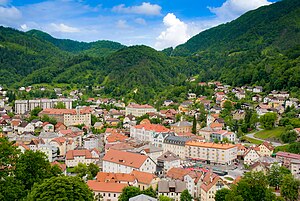Idrija lies among the green hills of western Slovenia in the Julian Alps. The ![]() UNESCO World Heritage Site is between the Alpine and the Karst regions.
UNESCO World Heritage Site is between the Alpine and the Karst regions.
Understand[edit]

As the oldest Slovenian mining city, Idrija grew with the development of the mercury mine. A mining settlement was founded at the end of 15th century. In 18th century Idrija as a city was considered one of the most important centers in Slovenia.
Until World War I Idrija stayed the second largest city in the region of Carniola. It was well connected with the most important European provinces and cities (Venice, Amsterdam, Vienna) and was a very interesting destination for scientific and technical elite of the time (Steinberg, Scopoli, Haquet, Lippold). Many of them left their mark on the city. Still today, names of many parts of the city remind us of various technical achievements from the old times: Bašerija - ore preparation, Prejnuta and Pront - ore furnace, Lejnštat and Riže - wood storehouse, Gasa - narrow street, etc.
Today Idrija has almost 7000 inhabitants. The mine closed down in 1996, but there are also mainly electronical and metalworking industries in the city. But even with the deviation to more modern industrial fields, the city is trying to preserve its links with 500 years of mining traditions.
A half millennium of mining mercury in Idrija and its surroundings left an exceptionally rich heritage of technical, cultural, and historical monuments and points of interest available to visitors as museum displays. The city's traditions in mercury mining has earned it an inscription on the UNESCO World Heritage List, shared with the town of Almadén in Spain.
Get in[edit]
Get around[edit]
See[edit]
- 1 Anthony Mine Shaft (Rudnik živega srebra Idrija Mercury Mine), Kosovelova 3. An old mercury mine that is now open for exhibition to guests. Guided tours available..
Do[edit]
- Lake Divje jezero is a carst spring, 2 km to the south, is at least 160 m deep. You can enjoy the rich flora and fauna in its serene surrounding.
Buy[edit]
One of the most adored Slovenian traditional crafts is Idrija Lace.
This fine, handmade traditional Slovenian product can be adored in the city museum. Those who won't settle just for looking, can also visit various galleries and studios, making and selling lace and lace products.
Eat[edit]
The traditional local cuisine is both rich and diverse in which the foremost place belongs to the delicacy popularly known as idrijski žlikrofi. It is a bit similar to ravioli stuffed with potato and chives. Traditionally it is served with bakalca, a stew made of mutton and onions.
Drink[edit]
Sleep[edit]
Connect[edit]
Go next[edit]

